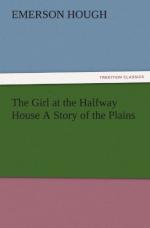It was only from a perfect understanding of the negro character that this proposal could come, and only a perfect dignity could carry it out with grace; yet there, beneath the floor of the wide prairie sea, these strange exercises were carried on, the low throbbing of the strings according with the quavering minors of the old-time hymns, until Aunt Lucy wiped her eyes and smiled.
“Thank yer. Miss Ma’y’ Ellen,” she said; “thank yer a thousand times. You shoh’ly does know how toe comfort folks mighty well, even a pore ole nigger. Law bless yer, honey, whut c’d I do without yer, me out yer all erlone? Seems like the Lord done gone ’way fur off, ’n I kain’t fotch him noways; but when white folks like Miss Ma’y Ellen Beecham come set down right side o’ me an’ sing wif me, den I know ther Lord, he standin’ by listenin’. Yas’m, he shoh’ly goin’ to incline his eah!”
Women are women. There is no synonym. Women, white and white, black and black, or, if need be, white and black, have sympathies and understandings and revealings which they never carry to the opposite sex. It is likely that no man ever explored the last intricacy of that sweet and wondrous maze, a woman’s heart; yet the woman who marries, and who has with her a husband, sets herself for the time outside the circle of all other husbandless women who may be about her. Thus it was that—without any loss of self-respect upon the one side, or any forgetfulness upon the other of that immovable line between black and white which had been part of the immemorial creed of both—Mary Ellen and Aunt Lucy, being companionless, sometimes drifted together in the way of things.
On the morning following Aunt Lucy’s devotional exercises that good soul seemed to be altogether happy and contented, and without any doubts as to her future welfare. She busied herself with the preparation of the food for the chickens, meantime half unconsciously humming a song in reminiscent minor. “Custard pie—custard pie,” she sang, softly, yet unctuously, as she stirred and mingled the materials before her; “custard pie—custard pie. Hope ter eat hit twell I die—twell I die.”
Mary Ellen was out in the open air, bonnetless and all a-blow. It was a glorious, sunny day, the air charged with some essence of vital stimulus. Tall and shapely, radiant, not yet twenty-three years of age, and mistress of earth’s best blessing, perfect health—how could Mary Ellen be sad? All the earth and sky, and the little twittering ground birds, and the bustling fowls, forbade it. The very stir of life was everywhere. She walked, but trod as steps the wild deer, lightly, with confidence, high-headed.
“Chick-chick-chick-chickee!” called Mary Ellen, bending over the fence of the chicken yard, and noting with pleasure the hurrying, clacking throng of fowls that answered and swarmed about her. “Chick, chick, chick!”
“I’ll be thah t’reckly wif ther feed, Miss Ma’y Ellen,” called out Aunt Lucy from the kitchen. And presently she emerged and joined her mistress at the corral.




